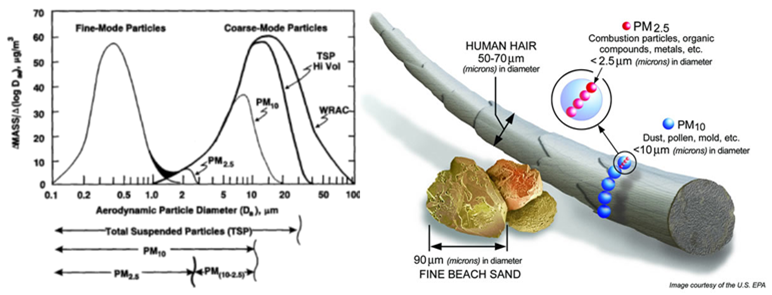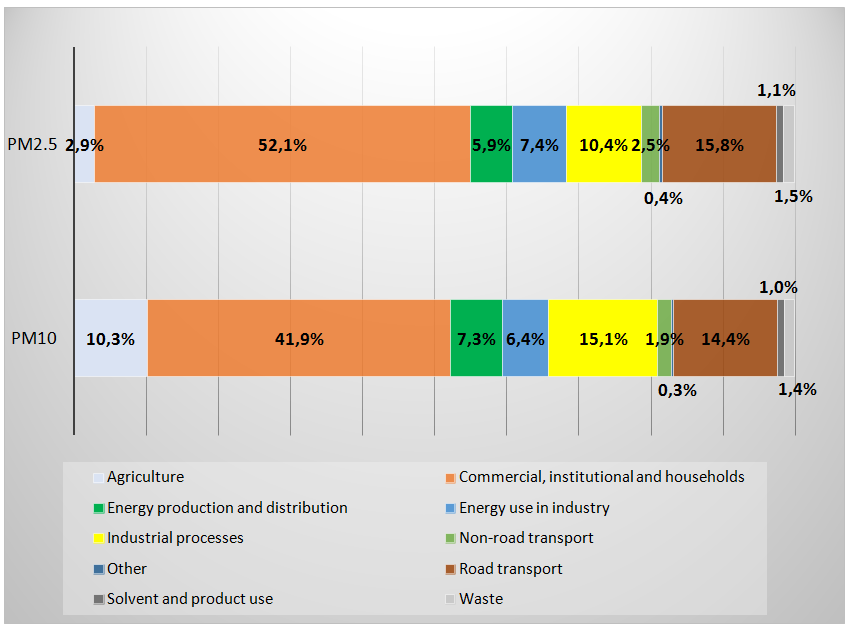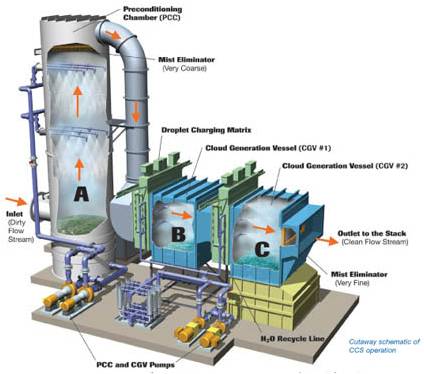Particulate Emission & Removal Technologies
Author: Mauro Capocelli, Researcher, University UCBM – Rome (Italy)
1. Theme description
Particulate matter (PM) is a complex mixture of micrometric particles and liquid droplets made up of organic soot (VOCs) as well as inorganic particles as soil, dust, metals and acids (nitrates and sulphates). The particle size, fundamental for the transport as well as the health effects, is usually classified by the aerodynamic diameter, the size of a unit-density sphere with equivalent aerodynamic characteristics (Figure 1). This size can vary over four orders of magnitude in the atmosphere; the largest ones (coarse fraction), mechanically produced, include pollen grains, mould spores, wind-blown dust from agricultural processes, sea spray, uncovered soil, unpaved roads or mining operations; the smallest ones (fine fraction) are mainly formed from gases by nucleation and coagulation at a scale lower than 0.1-1 μm (accumulation range). Moreover, secondary aerosol can be formed by chemical and physical reactions in the atmosphere as acidic forms (from sulphuric and nitric acid) and ammonium salts (in the presence of ammonia). The carbonaceous fraction of aerosols is composed by organic matter (either primary or secondary if deriving from the oxidation of VOCs) and elemental carbon (EC, also known as black carbon, BC).
Fig. 1 – Size distribution of particulate matter
Sources and effects
Figure 2 represents the contribution of PM pollution from different sectors and activities in european countries. The particles produced by combustion processes represent the largest portion of the anthropogenic sources. Large stationary sources are related to the Power Generation and, in minor part, directly to the oil & gas industry. The major exposure risks are related to domestic heating while transport (urban traffic and emission of the diesel engines of harboured vessels) is the second relevant source inhabited areas. Gas flaring is recognized as an important source of pollution, even though limited to specific zones [1]. The uncontrolled gas flaring can generate emissions of unburned hydrocarbons, particulates and polycyclic aromatic hydrocarbons (PAH). Every year, approximately 140-150 billion cubic meters of natural gas is flared into the atmosphere (equivalent to three quarters of Russia’s gas exports, or almost one third of the European Union’s gas consumption [2]). In 2011 Johnson et al., measured the soot emission from a large gas flare in Uzbekistan; they highlighted a potentially dramatic environmental impact of gas flaring, calculating a soot emission rate of 7400 g/h comparable to ∼500 buses constantly driving and estimable in 275 trillion soot aggregates per second [3].
Fig. 2 – Sector contributions of emissions of primary particulate matter and secondary precursors in EEA member countries [4]
Exposure to particulate matter is associated to serious health effects as respiratory and cardiovascular disease depending on the specific particle size, morphology and composition. The PM size is directly linked to the damaging potential: very fine inhalable particles remain suspended in the atmosphere for a long time traveling long distances from the emitting sources and, once inhaled, reach the deepest regions of the lungs entering in the circulatory system. Generally, the lower is the particle size (and the higher specific area), the higher is its toxicity, also due to absorption of pollutants affecting human health with specific actions (carcinogen and mutagen compounds). Heart attacks with associated premature death, irregular heartbeat, asthma, decreased lung function, and several respiratory symptoms, such as irritation of the airways, coughing or difficulty breathing are among the PM exposure recognized issues [5]. PM pollution is estimated to cause more than 50000 deaths per year in the United States and 200,000 deaths per year in Europe [6]. Fine particles impact extended ecosystems by traveling over long distance, reducing the visibility, polluting ground and surface waters as well as acting on the climate changes and global warming (BC is the second most important climate warming agent after CO2, having a radiative index of 1.1 W/m2). An other climate effect is the cloud formation since they act as water condensation nuclei [5].
2. Removal technologies
The removal technologies utilizes different strategies to separate solid particles from the flowing gas: to intercept particles by acting on the particle size and shape (filtration and scrubbing); to exploit external force fields such as gravitational, electrical and centrifugal.
Filtration
In a Fabric Filter (FF), waste gas is forced to pass through a tightly woven or felted fabric, collecting particulate matter on the fabric by sieving and other related mechanisms. Fabric filters can be in the form of sheets, cartridges or bags (the most common type) with a number of the individual filtering units housed together in a group. When low particles loads occur, filter collection efficiency is primary related to the filter pore size and length. High particulate loading forms a “cake” on the filter surface increasing the collection efficiency.
Fabric filters are used, primarily, to remove particulate matter (and other hazardous air pollutants in particulate form such as metals) at moderate loads (and gas flow rate limit of 2•106 Nm3/h) down to PM2.5. This technology is useful to collect particulate matter with electrical resistivity either too low or too high for Electrostatic Precipitator, so they are suitable to collect fly ash from low-sulphur coal or fly ash containing high levels of unburnt carbon [7]. The cleaning intensity and frequency are important variables in determining removal efficiency (the dust cake provides an increased fine particulate removal) and the pressure drop across the fabrics (ΔP 100-500 mbar) and the consequent energy requirement (0.2-2 kWh/1000Nm3). Catalytic filtration is commonly adopted in the new generation of diesel particulate filters, DPF, for the automotive application. Commonly the oxidation catalyst and the particulate filter are combined and particles can be burnt off continually. The catalyst filter consists of an expanded polytetrafluoroethene membrane, laminated to a catalytic felt substrate. It is used to separate particulate and eliminate hazardous contaminants from the gaseous phase, such as dioxins and furans, but also aromatics, polychlorinated benzenes, polychlorinated biphenyls, volatile organic compounds and chlorinated phenols. The filtration efficiencies of DPF is > 99% for solid matter (globally > 90% considering a non-solid portion). These systems can be alternatively designed to trap a portion of the total particle load (e.g. the 70% instead of the 100%) in order to obtain a lower back pressure and a blocking risk.
Gravity and Centrifugal force
Larger particles can be removed from flue gas by exploiting gravity/mass inertia and internal obstructions. A separator chamber can be installed as a preliminary step to prevent entrainment of the washing liquid with the purified waste gas and/or to remove dust, aerosols and droplets. Also abrasive particles can be treated in order to preserve the downstream equipment. The separation occurs by impact with properly designed internal surfaces, like baffles, lamellae or metal gauzes. The main advantages of separators are the suitability for higher temperatures as well as the lack of moving parts, which determines low maintenance and low pressure drop. On the contrary, the low removal efficiency makes it unsuitable for systems with small density differences between gas and particles. By exploiting centrifugal forces, the separation can be achieved through cyclones. In a purposely designed conical chamber, the incoming gas is forced into circular motion down the cyclone near the inner surface of the cyclone tube. Particles in the gas stream are forced toward the cyclone walls by the centrifugal force of the spinning gas; the larger ones, reaching the cyclone walls, fall down in a bottom hopper where are collected. These simple devices are used to primarily control particles over PM10 (pre-cleaners for more expensive final control devices such as fabric filters or electrostatic precipitators); high efficiency cyclones can be designed to be effective even for PM2.5. The main advances of classical separation chambers are kept in these conical arrangements.
Wet Scrubbing
Wet scrubbers (WS) realize the interception of PM through the direct contact with liquid droplets. WS can assembled with variable geometries to each of which optimized in a specific gas flow rate; in relation to the contact dynamics they are arranged in the form of spray towers, packed bed scrubber and Venturi scrubbers (Figure 3). This last realizes the acceleration of the gas stream in a throat to atomize the scrubbing liquid and to improve gas-liquid contact (Figure 3).
Fig. 3 – Schematic of a Venturi Wet Scrubber [8]
Liquid scrubbers are used in case of removal/recover of flammable and explosive dusts as well as treatment of gaseous compounds. Furthermore, WS as the advantage to cool and supersaturate the gas stream leading to particle scrubbing by condensation. WS can operate at medium/high collection efficiency and low cost. On the other hand, the main disadvantages of WS are the risk of corrosion and freezing, the generation of a liquid by-product and the low particle collection efficiency in the 0.1-2µm range.
Electrostatic force
The Electrostatic precipitator (ESP) utilizes electrical forces to move particles in gas streams into collector plates. It can be “wire-plate” if gas flows horizontally and parallel to vertical plates of sheet material and wire-pipe if the electrodes are long wires running through the axis of each tube. The entrained particles acquire an electrical charge passing through a corona field generated by discharge electrodes (DC voltage required in the range of 20-100kV). ESP has high efficiency and low pressure drop. Main disadvantages are related to the maintenance of the high voltage generation (electrodes cleaning) as well as the danger of dust explosion after discharges. In 2006 Javorek et al.[9], have realized a comprehensive review of the wet ESP state-of-the-art for gas cleaning (mainly dust or smoke particles). In a single stage ESP, the charging and discharging (collecting at the electrode) take place in one device while in a two stage ESP, charging and removal of the particles occur in separate electric fields (and consequently separate chambers). The two stage ESP is common for small waste gas streams (<90000 Nm3/h) characterized by a high concentration of micrometric and sub-micrometric particles (e.g. smoke or oil mist). EPA gives a detailed overview of ESP types, configurations and designing procedure [10].
3. Innovative technologies
The more stringent environmental evidences and the recent emission regulations are forcing the development of more effective gas cleaning technologies (particularly effective in the submicronic sizes). The existing technologies have low efficiency in the particle diameter range 0.01-1µm, called Greenfield gap region . As aforementioned, the capture of the particulate matter is usually carried out by fabric filters and electrostatic precipitators, which are the actual best available technologies. However, these units shown limited efficiency in capturing particles of submicron or nanometres size. Moreover, the ESP technology is ineffective for particle resistivity out of the range 108-1011Ωcm and for gas streams containing water droplets. On the other hand, FF cannot be used if the water content in the flue gas can produce condense on the cake deposited on the bags. Therefore, a new challenge of the scientific research is the development of new cleaning systems to remove particles from flue gas and the optimization of the existing technologies in order to improve the particle capture of submicronic particles [11]. An example is the research activity in the field of diesel particulate abatement where several strategies are under development, particularly in the ship emission context. As the emissions from diesel ship engine represent an emerging issue, the International Maritime Organization has enforced the environmental regulations. A consortium of European Universities and Industrial Partners developed a modular on-board process combining different units to remove specific primary pollutants (SOx, NOx, PM and VOC) participating to the European Seventh Framework Programm [12]. The PM removal technology, developed by The University of Naples consisted in an innovative upgrade of a wet scrubbing device . In fact, the Wet electrostatic Scrubber (WES) increases the scrubber collection efficiency by sweeping the precipitation chamber with charged droplets. These act as small collectors attracting the particles due to Coulomb force. A practical example of this phenomena is the scavenging of atmospheric aerosol during thunderstorms with the achievement of highest removal efficiency [13]. Different charging and spraying configurations are possible and PM can be charged either negatively or positively with opposite polarity droplets. A commercial application of this interesting technology is the Cloud Chamber Scrubber (CCS) by Tri-Mer Corporation (Figure 4) [14]. It is composed of three zones: preconditioning chamber (A) for the removal of coarse particles and humidity/temperature adjustment; cloud generation vessel (B) for the removal of neutral and negative submicronic particles; second cloud generation vessel (C) with negatively charged droplets so that neutral and positive particles are captured. Afterwards treated air flows through a mist eliminator, before discharge (particles between 0.1 and 2.5 µm).
Fig. 4 – Layout of the Cloud Chamber Scrubber [14]
___________________________




